天然气调压计量站设计基础
天然气站场的计量调压设计分析

天然气站场的计量调压设计分析天然气作为一种城市生产生活重要的能源,在进入用户终端前需要经过城市门站的调压、计量等功能操作。
要提高天然气管网运行的经济收益和能源利用效率,科学配置天然气门站的计量和调压系统极为关键。
分别从天然气门站计量、调压及流量控制方面提出了工艺设计要点。
标签:天然气计量;调压系统;流量控制随着城市天然气需求的不断增长,天然气站场调压计量的稳定性和可靠性越来越受到人们的关注。
城市天然气供应的气源点通常要具备天然气过滤、调压、计量、安全切断、运行路和备用路自动切换等功能,而调压与计量系统是气源稳定、安全运行的关键,同时也是保证天然气管理部门经济效益的重要环节。
1 计量系统天然气流量的计量是保证天然气供应管理的经济效益和流量输配稳定的关键,因此,科学地设计和配置天然气城市门站计量系统,尽量提高其准确性和可靠性是计量系统设计的关键。
在进站高压流量计之间设计对比流程,在两个并联流量计之间增加串联回路。
在流量计标定门站调压计量系统工艺流程时,将其中任一路的流量计临时更换为标准气体流量计,即可对另一路流量计进行标定。
此设计方案的优点是可使标准气体流量计和被检测的流量计均在相同的压力条件下运行;缺点是由于标准气体流量计的某一组仪表常数是在与之相应的操作条件不变的情况下测得的,在对串联的被检测流量计进行标定时,运行工况会因天然气门站对外供气而发生变化,因此需对标准气体流量计本身在不同压力条件下进行检定,以保证其仪表常数的准确性和有效性。
调压单元每一调压路均采用两台调压器串联连接而成。
监控调压器给定出口压力略高于工作调压器的出口压力,正常情况下,监控调压器的阀口全开,当工作调压器失灵,出口压力上升到监控调压器的出口压力设定值时,监控调压器投入运行。
当运行路发生事故,出口压力仍然上升,运行路上的超压切断阀发生作用,将运行路关断,备用路能自动运行供气。
运行路和备用路的工作调压器和监控调压器的出口压力应为不同的设置。
关于天然气站场计量调压设计的相关研究
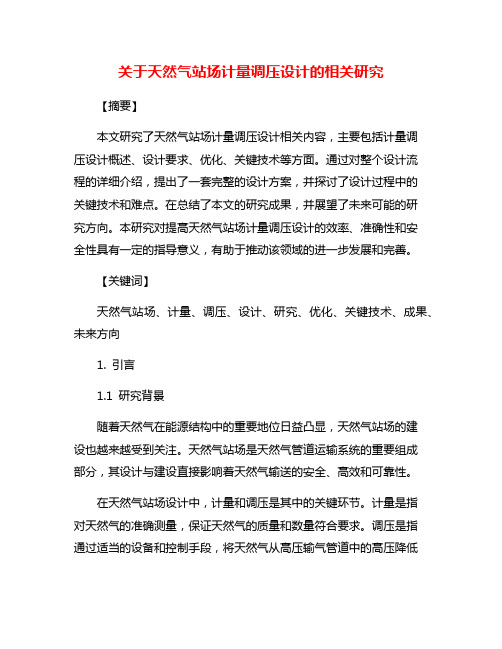
关于天然气站场计量调压设计的相关研究【摘要】本文研究了天然气站场计量调压设计相关内容,主要包括计量调压设计概述、设计要求、优化、关键技术等方面。
通过对整个设计流程的详细介绍,提出了一套完整的设计方案,并探讨了设计过程中的关键技术和难点。
在总结了本文的研究成果,并展望了未来可能的研究方向。
本研究对提高天然气站场计量调压设计的效率、准确性和安全性具有一定的指导意义,有助于推动该领域的进一步发展和完善。
【关键词】天然气站场、计量、调压、设计、研究、优化、关键技术、成果、未来方向1. 引言1.1 研究背景随着天然气在能源结构中的重要地位日益凸显,天然气站场的建设也越来越受到关注。
天然气站场是天然气管道运输系统的重要组成部分,其设计与建设直接影响着天然气输送的安全、高效和可靠性。
在天然气站场设计中,计量和调压是其中的关键环节。
计量是指对天然气的准确测量,保证天然气的质量和数量符合要求。
调压是指通过适当的设备和控制手段,将天然气从高压输气管道中的高压降低到用户需要的低压。
天然气站场的计量调压设计对天然气输送的安全和稳定至关重要。
目前国内关于天然气站场计量调压设计的研究还比较有限。
对于天然气站场计量调压设计的概念、要求以及优化方法等方面还存在诸多问题和待解决的挑战。
开展这方面的研究对于提高天然气站场设计水平、保障国家能源安全具有重要的理论和实际意义。
1.2 研究目的本研究的目的是对天然气站场计量调压设计进行深入研究,探讨其相关要求和优化方法,为提高天然气站场设计效率和质量提供参考。
具体目的包括:1.分析天然气站场计量调压设计的基本概念和原理,建立完善的设计框架。
2.总结天然气站场计量设计和调压设计的要求,明确设计中需要考虑的关键因素。
3.探讨天然气站场计量调压设计的优化方法,提出提高设计效率和确保安全性的技术方案。
通过研究目的的实现,可以为相关领域的设计人员和研究者提供指导,并为天然气站场计量调压设计的进一步研究提供理论支持。
浅谈城市燃气调压计量站的设计
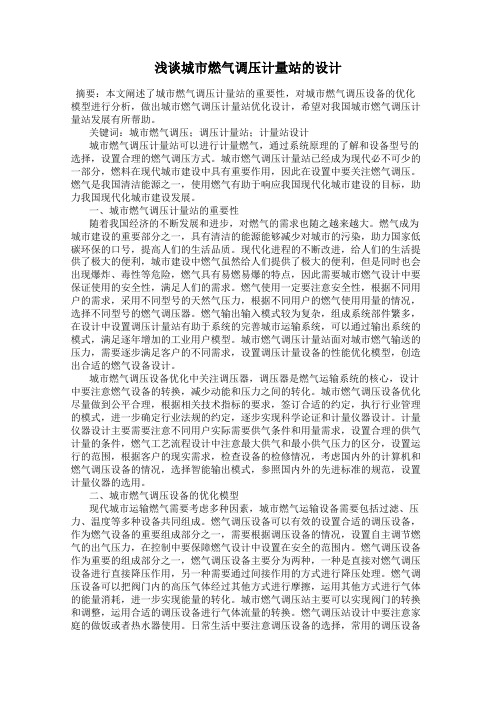
浅谈城市燃气调压计量站的设计摘要:本文阐述了城市燃气调压计量站的重要性,对城市燃气调压设备的优化模型进行分析,做出城市燃气调压计量站优化设计,希望对我国城市燃气调压计量站发展有所帮助。
关键词:城市燃气调压;调压计量站;计量站设计城市燃气调压计量站可以进行计量燃气,通过系统原理的了解和设备型号的选择,设置合理的燃气调压方式。
城市燃气调压计量站已经成为现代必不可少的一部分,燃料在现代城市建设中具有重要作用,因此在设置中要关注燃气调压。
燃气是我国清洁能源之一,使用燃气有助于响应我国现代化城市建设的目标,助力我国现代化城市建设发展。
一、城市燃气调压计量站的重要性随着我国经济的不断发展和进步,对燃气的需求也随之越来越大。
燃气成为城市建设的重要部分之一,具有清洁的能源能够减少对城市的污染,助力国家低碳环保的口号,提高人们的生活品质。
现代化进程的不断改进,给人们的生活提供了极大的便利,城市建设中燃气虽然给人们提供了极大的便利,但是同时也会出现爆炸、毒性等危险,燃气具有易燃易爆的特点,因此需要城市燃气设计中要保证使用的安全性,满足人们的需求。
燃气使用一定要注意安全性,根据不同用户的需求,采用不同型号的天然气压力,根据不同用户的燃气使用用量的情况,选择不同型号的燃气调压器。
燃气输出输入模式较为复杂,组成系统部件繁多,在设计中设置调压计量站有助于系统的完善城市运输系统,可以通过输出系统的模式,满足逐年增加的工业用户模型。
城市燃气调压计量站面对城市燃气输送的压力,需要逐步满足客户的不同需求,设置调压计量设备的性能优化模型,创造出合适的燃气设备设计。
城市燃气调压设备优化中关注调压器,调压器是燃气运输系统的核心,设计中要注意燃气设备的转换,减少动能和压力之间的转化。
城市燃气调压设备优化尽量做到公平合理,根据相关技术指标的要求,签订合适的约定,执行行业管理的模式,进一步确定行业法规的约定,逐步实现科学论证和计量仪器设计。
计量仪器设计主要需要注意不同用户实际需要供气条件和用量需求,设置合理的供气计量的条件,燃气工艺流程设计中注意最大供气和最小供气压力的区分,设置运行的范围,根据客户的现实需求,检查设备的检修情况,考虑国内外的计算机和燃气调压设备的情况,选择智能输出模式,参照国内外的先进标准的规范,设置计量仪器的选用。
浅论天然气厂调压计量站系统的设计

浅论天然气厂调压计量站系统的设计【摘要】现代城市天然气输配系统包含着复杂的能源综合设施,输电和配电网络,并同时肩负了各类天然气厂不同的压力水平(门站、调压站等)和信息收集功能,通过管理层维护软件和硬件系统。
根据不同类型的城市天然气门站例如煤气调压站和CNG填充操作站等,其供给的不同标准特性在其调节计量系统中,采取不同的配置和选择,为此本文进行了以下讨论。
【关键词】天然气;调压站设计;流量计选型;工艺流程1 天然气体厂站系统概述1.1 天然气厂调压计量概述1.1.1 计量单位在两个平行的流量计之间增加串联电路,并在两个高压流量计之间设置相互对比的过程。
无论哪种方式的临时替代品在标准气体的流量设计方面,仪器都可以以另一种方式进行校准。
这种设计的优点是使气体标准化,在相同的压力条件下使得测试计得以运行;其缺点是由于某一组气体流量计在恒定标准下用相同的操作方式,使得相应的(ⅳ)被检测到,该操作是由于在自然的供给情况下,这一系列流量计校准时气站发生的外部变化造成的,因此需要对标准气体流量计在不同的压力条件下进行校准,以确保仪器常数的准确性和有效性。
1.1.2 调节装置每路调节器均使用两个串联的电压调节器。
监视器在调节出口压力时,大于给定工作调节压力。
一般情况下,出口压力稍高,监视调节阀口就会打开,而当工作调节器出现故障时,出口压力就会升高。
当出现操作事故时,出口压力持续上升,工作调节器和监视器通过调节出口压力,来运行的备用路径就会被重新设定。
设定压力调节器的出口降序排列为:道路监控器,运行道路工程,备用道路监控调压器,备用道路工作调压稳压器。
当监管机构在开放状态使用时出现故障,调压器出现故障,监管压力上升就开始使用监控器。
1.2 流量计选型设计天然气上游的燃气计量站通常进行交接计量,随着测量技术的不断发展,计量交接仪从过去使用孔板流量计,到现在涡街流量计被不断使用,再发展到目前的涡轮流量计和超声波流量计。
浅析天然气分输站的计量调压设计
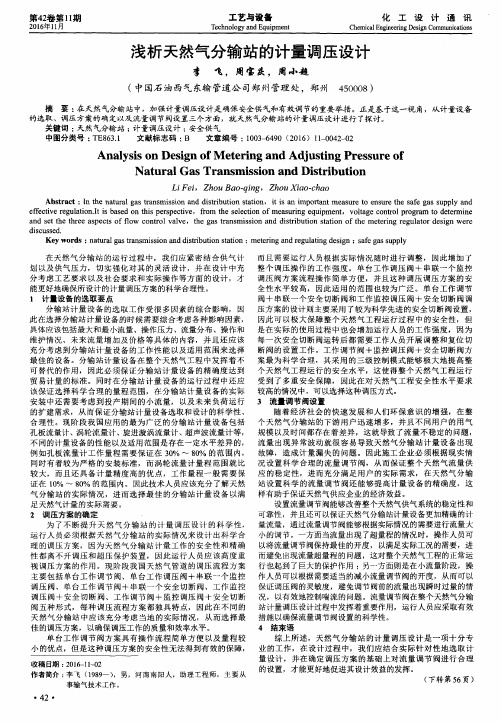
浅 析天然气分 输站的计 量调压设计
李 飞 ,周宝 庆,周小超
( 中国石 油西气东输管道公 司郑 州管理处 ,郑州 4 5 0 0 0 8 )
摘 要: 在天然气分输站 中,加 强计量调 压设 计是确保 安全供 气和有 效调 节的重要举措 。正是基 于这一视 角 ,从计量设备 的选取、调压 方案的确定以及 流量调节阀设 置三 个方面,就天然气分输 站的计量调压设计进行 了探 讨。 关键词 : 天然气分输站 ; 计量调压设计 ; 安全供 气 中图分类号 : T E 8 6 3 . 1 文献标志码 : B 文章编号 :1 0 0 3 — 6 4 9 0( 2 0 1 6 )1 1 — 0 0 4 2 — 0 2
第4 2 卷第1 l 期
2 0 1 6 年1 1 月
工艺与设备
T e c h n o l o g y a n d E q ui p me nc a l E n g i n e e r i n g De s i g n Co mmu n i c a t i o n s
An a l y s i s o n De s i g n o f Me t e r i n g a n d Ad j u s t i n g P r e s s u r e o f
Na t u r a l Ga s Tr a n s mi s s i o n a n d Di s t r i b u t i o n
Li Fe i , Zh ou Ba o — q i n g, Zh o uXi a o — c h ao
Ab s t r a c t:I n t h e n a t u r a l g a s t r a n s mi s s i o n a n d d i s t r i b u t i o n s t  ̄i o n, i t i s a n i mp o r t a n t me a s u r e t 0 e n s u r e t h e s a f e g a s s u p p l y a n d e fe c t i v e r e g u l a t i o n . I t i s b a s e d o n t h i s p e r s p e c t i v e ,f r o m t h e s e l e c t i o n o f me a s u r i n g e q u i p me n t ,v o l t a g e c o n t r o l p r o g r a m t o d e t e r mi n e a n d s e t t h e t h r e e a s p e c t s o f f l o w c o n t r o l v a l v e ,t h e g a s t r a n s mi s s i o n a n d d i s t r i b u t i o n s t a t i o n o f t h e me t e r i n g r e g u l a t o r d e s i g n we r e d i s c u s s e d . Ke y wo r d s: n a t u r a l g a s t r a n s mi s s i o n a n d d i s t r i b u t i o n s t a t i o n;me t e r i n g a n d r e g u l a t i n g d e s i g n ;s a f e g a s s u p p l y
浅谈城市天然气门站的调压计量工艺设计
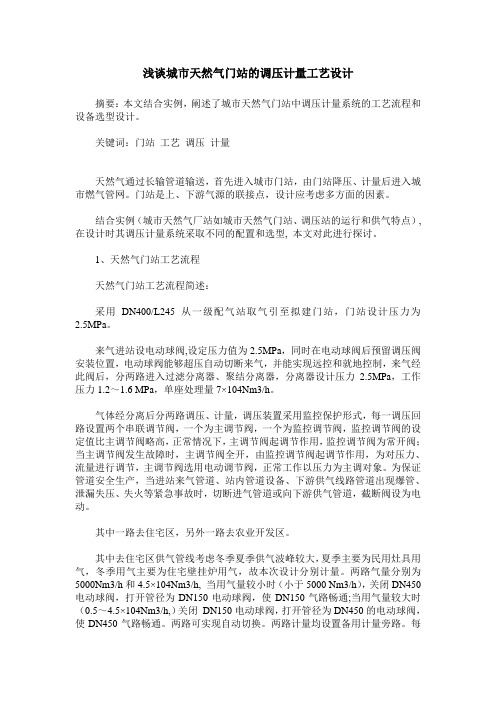
浅谈城市天然气门站的调压计量工艺设计摘要:本文结合实例,阐述了城市天然气门站中调压计量系统的工艺流程和设备选型设计。
关键词:门站工艺调压计量天然气通过长输管道输送,首先进入城市门站,由门站降压、计量后进入城市燃气管网。
门站是上、下游气源的联接点,设计应考虑多方面的因素。
结合实例(城市天然气厂站如城市天然气门站、调压站的运行和供气特点), 在设计时其调压计量系统采取不同的配置和选型, 本文对此进行探讨。
1、天然气门站工艺流程天然气门站工艺流程简述:采用DN400/L245从一级配气站取气引至拟建门站,门站设计压力为2.5MPa。
来气进站设电动球阀,设定压力值为2.5MPa,同时在电动球阀后预留调压阀安装位置,电动球阀能够超压自动切断来气,并能实现远控和就地控制,来气经此阀后,分两路进入过滤分离器、聚结分离器,分离器设计压力2.5MPa,工作压力1.2~1.6 MPa,单座处理量7×104Nm3/h。
气体经分离后分两路调压、计量,调压装置采用监控保护形式,每一调压回路设置两个串联调节阀,一个为主调节阀,一个为监控调节阀,监控调节阀的设定值比主调节阀略高,正常情况下,主调节阀起调节作用,监控调节阀为常开阀;当主调节阀发生故障时,主调节阀全开,由监控调节阀起调节作用,为对压力、流量进行调节,主调节阀选用电动调节阀,正常工作以压力为主调对象。
为保证管道安全生产,当进站来气管道、站内管道设备、下游供气线路管道出现爆管、泄漏失压、失火等紧急事故时,切断进气管道或向下游供气管道,截断阀设为电动。
其中一路去住宅区,另外一路去农业开发区。
其中去住宅区供气管线考虑冬季夏季供气波峰较大,夏季主要为民用灶具用气,冬季用气主要为住宅壁挂炉用气,故本次设计分别计量。
两路气量分别为5000Nm3/h和4.5×104Nm3/h, 当用气量较小时(小于5000 Nm3/h),关闭DN450电动球阀,打开管径为DN150电动球阀,使DN150气路畅通;当用气量较大时(0.5~4.5×104Nm3/h,)关闭DN150电动球阀,打开管径为DN450的电动球阀,使DN450气路畅通。
天然气计量系统设计基本准则
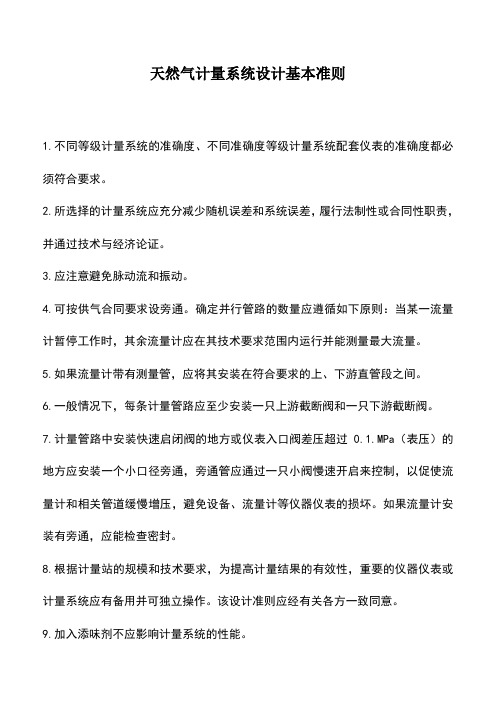
天然气计量系统设计基本准则1.不同等级计量系统的准确度、不同准确度等级计量系统配套仪表的准确度都必须符合要求。
2.所选择的计量系统应充分减少随机误差和系统误差,履行法制性或合同性职责,并通过技术与经济论证。
3.应注意避免脉动流和振动。
4.可按供气合同要求设旁通。
确定并行管路的数量应遵循如下原则:当某一流量计暂停工作时,其余流量计应在其技术要求范围内运行并能测量最大流量。
5.如果流量计带有测量管,应将其安装在符合要求的上、下游直管段之间。
6.一般情况下,每条计量管路应至少安装一只上游截断阀和一只下游截断阀。
7.计量管路中安装快速启闭阀的地方或仪表入口阀差压超过0.1.MPa(表压)的地方应安装一个小口径旁通,旁通管应通过一只小阀慢速开启来控制,以促使流量计和相关管道缓慢增压,避免设备、流量计等仪器仪表的损坏。
如果流量计安装有旁通,应能检查密封。
8.根据计量站的规模和技术要求,为提高计量结果的有效性,重要的仪器仪表或计量系统应有备用并可独立操作。
该设计准则应经有关各方一致同意。
9.加入添味剂不应影响计量系统的性能。
10.计量系统任何外围设备的设计都不能影响计量过程。
如果添味剂的添加位置和天然气计量位于同一计量站内,宜在流量计下游注入添味剂流量调节阀或类似装置引起的气体压力和流量的波动,可能影响一次计量仪表的准确度,在设计阶段应将其影响控制在最小。
11.安装加热器的计量站,流量计上游管段的气流温度应控制在一个可接受的范围内,这个范围是在正常的工作条件下额定流量的500~100%流量之间设定的。
这个设定温度可接受的范围取决于所指定的主要仪表及转换装置的温度范围12.仪表读数设备和记录仪以及监控设备可与通信系统连接。
天然气长输管线中间调压计量站设计论文汇编

天然气长输管线中间调压计量站设计论文汇编摘要天然气调压计量站是天然气输配工程的重要组成部分。
其主要任务是调节输气管线的压力、计量气体流量以及脱除天然气中含有的液滴和机械杂质等,在天然气的输送与分配过程中占有重要地位。
本文是天然气长输管线中间调压计量站的工艺设计,该站集调压、计量、清管和气体分离功能于一体,是典型的中间调压计量站。
长输管线来气在该站经分离后,一部分经调压计量输送至用户;另一部分经计量后进入干线。
按照调压计量站应简洁准确、安全可靠、经济高效的设计思路,对该站场主要工艺进行了设计。
设计中充分考虑了基本工艺参数和工艺要求,依据相关规范标准,确定了主要设备的设计、选型、安装的原则和方法。
在此基础上,对主要设备进行了工艺计算和选型,并绘制了站场的工艺流程图、平面布置图和平面安装图。
设计结合了具体工程要求,采用成熟的设计方法和工艺流程,严格遵循最新规范标准及国家有关政策法令,最终完成了一套完整的调压计量站设计方案。
关键词:天然气;调压站;计量;设计;工艺流程AbstractNatural gas regulating metering station is an important component of the project of gas transmission and distribution .Its major task is to regulate the pressure on gas pipeline, gas flow measurement and removal of the droplets and machinery impurities containing in natural gas .it occupies an important position in the natural gas transmission and distribution process.This article is about the process design of regulating metering station at the middle of the long-distance pipeline, the station setting the functions of pressure regulation, flow measurement, and gas purification in one is a typical middle regulating metering station. Part of the gas from long-distancepipeline separated at the station, after pressure regulation and flow measurement is delivered to the users; another part of the gas through flow measurement directly flow into the Gas Transmission Line. The mainly technological design of the station is in accordance with the design philosophy of regulating metering station should be simple accurate, secure, reliable, cost-effective. The design takes full account of the basic technical parameters and technological requirements and based on relevant standards to determine the principles and methods of the major equipments’ design, selection and installation. On this basis, the major equipment were calculated and selected, and a engineering flow diagram, site plan and Planar installed Fig of the station has been drawn.The design has combined the specific engineering requirements, used proven technique and technological process, strictly follow the latest standards and the relevant state policies.Finally, a entire station design proposal has been finished.Keywords: natural gas; regulating metering station; flow measurement; design目录1 绪论 (1)1.1 设计目的和意义 (1)1.2 目前国内技术概况 (1)1.3 设计依据 (2)1.3.1 原始资料 (2)1.3.2 编制原则 (2)1.3.3 遵循的标准规范 (2)1.3.4 基本物理化学参数 (3)1.3.5 设计内容 (3)1.4 可行性分析 (3)2 设计说明书 (4)2.1 调压计量站的总体规划 (4) 2.1.1 调压计量站站址的选择 (4) 2.1.2 调压计量站设计路线选择 (4) 2.1.3 调压计量站工艺流程 (5) 2.1.4 清管工艺流程 (6)2.1.5 调压计量站消防设计 (8) 2.2 主要工艺设备的设计和安装 (9) 2.2.1 管线设计与安装 (9)2.2.2 焊接和法兰连接 (11)2.2.3 汇管的设计和安装 (12)2.2.4 阀门 (12)2.2.5 安全阀 (14)2.2.6 调压器 (15)2.2.7 流量计 (16)2.2.8 压力温度测量仪表 (18)2.3 吹扫与试压 (19)2.3.1 吹扫 (19)2.3.2 试压 (19)2.4 防腐 (19)2.5 环保 (19)3. 计算说明书 (21)3.1 设计参数 (21)3.1.1 已知参数的单位换算 (21) 3.1.2 天然气基本参数的计算 (21) 3.2 管道设计 (24)3.2.1 管道计算 (24)3.2.2 管道选择 (26)3.3 安全阀 (26)3.3.1 安全阀的计算 (26)3.3.2 安全阀选型 (27)3.4 汇管 (27)3.4.1 管径计算公式 (27)3.4.2 壁厚计算公式 (28)3.4.3 汇管椭圆封头计算 (29)3.5 分离器 (30)3.5.1 分离器的计算 (30)3.5.2 分离器进出口管径和壁厚计算 (32)3.6 调压器 (34)3.6.1 调节阀通过能力的计算 (34)3.6.2 调节阀的选型 (35)3.7 流量计 (35)3.7.1 天然气在标准参比条件下的体积流量计算实用公式 (35)3.7.2 流量计算中主要参数的确定 (36)3.8 阀门 (39)3.8.1 球阀 (39)3.8.2 闸阀 (40)3.9 压力及温度测量仪表 (40)3.9.1 温度测量仪表 (40)3.9.2 压力测量仪表 (41)结论 (42)致谢 (43)参考文献 (44)附录部分 (46)LLH调压计量站工艺设计1 绪论1.1 设计目的和意义随着经济的快速发展、治理大气环境的力度不断增大和广大市民生活质量的不断提高,天然气这一清洁能源的需求量也逐年大幅增加。
- 1、下载文档前请自行甄别文档内容的完整性,平台不提供额外的编辑、内容补充、找答案等附加服务。
- 2、"仅部分预览"的文档,不可在线预览部分如存在完整性等问题,可反馈申请退款(可完整预览的文档不适用该条件!)。
- 3、如文档侵犯您的权益,请联系客服反馈,我们会尽快为您处理(人工客服工作时间:9:00-18:30)。
4.3 RMS Design
Key point of RMS design includes the following items: Pipe Line sizing calculation and design Knock-out Drum / Filter Separator / Liquid Separator sizing calculation and design Dry Gas Filter sizing calculation and design WBH sizing calculation Regulator, Relief Valves and SSV sizing calculation
4.2 Basic Technology of RMS Design
Basis of RMS Design The following information must be collected before starting RMS design: Inlet Pressure (Max. / Normal / Min.) : Psig / Barg Inlet Temperature (Max. / Normal / Min.): Deg. F / Deg. C
Outlet Pressure (Max. / Normal / Min.): Psig / Barg Required Outlet Temperature (Max. / Normal / Min.): Deg. F / Deg. C Flow Rate (Max. / Normal / Min.) : MMSCFD / SCMH Gas property: Composition / Specific Gravity / Water Content etc. Normally, the customer may give some extra requirements regarding the equipments as follows: Knock-out Drum: Required / Not Required Filter Separator: Required / Not Required Liquid Separator: Required / Not Required Water Bath Heater: Required / Not Required Streams of Regulating: One / Two / Others Regulating Style: Active / Monitor + Active Meter Type: Turbine / Orifice / Ultrasonic / Others Streams of Metering: One / Two / Others Location of Meter: Before Regulation / After Regulation / Others All the information listed above is the basis of RMS design.
4. Technics involes of project works on RMS
4.1 Introduction to Gas Regulating & Metering Station (RMS)
RMS is designed to reduce the pressure of natural gas from high pressure to low pressure, and calculate how much gas flow passes through the station. As a standard practice, a RMS for the natural gas power station usually consists of gas conditioning, regulating and metering systems. Gas conditioning system usually consists of inlet Knock-Out Drum, Two-stage Filter Separator, Water Bath Heater and Liquid Separator and related instruments. For a simple RMS, Dry Gas Filter is widely used. Conditioning system is used to remove the liquid such as heavy hydrocarbons, water etc. which are usually carried by the gas and will cause damage to regulator seats, turbine meter blades, and customer equipment. Conditioning system is also used to remove the sand, welding slag, pipeline scale, and other solids which can damage equipment. In order to remove the liquids and particles, stations can be protected by separators. Knock-out Drum, Filter Separator, Liquid Separator and Dry Gas Filter are widely used in this application. Water vapor is also a common impurity that can cause pilot or main regulator freezing, loss of control, loss of flow capacity, and internal corrosion. Water vapor can be controlled by either removing it or by limiting its detrimental effects, using a heater to avoid freezing. And also, the temperature of natural gas supplied is very important for gas generators. Water Bath Heater is widely used to heat the natural gas and maintain the temperature supplied to gas generator. Thus, gas conditioning system is usually used in a typical RMS. Gas Regulating System usually consists of inlet insulating valve, Slam Shut-off Valve, Gas Regulators (Monitor regulator and Active Regulator), outlet insulating valves and related instruments. Regulating system is to reducing the gas pressure from a high pressure to a certain lower pressure which normally required by customer. Over pressure protection is included in this system. Gas Metering System usually consists of inlet insulating valve, Gas Flow Meter, outlet insulating valve and related instruments. Metering system is to measure how much gas flow pass through the RMS. Other than the systems mentioned above, some other equipments such as flow control, chromatography, composite sampling, odorization etc. may also required.
Pg = Pa – Po
Where:
ቤተ መጻሕፍቲ ባይዱ
(F – 1)
2
Pg = Gauge Pressure Pa = Absolute Pressure Po = Atmospheric Pressure Standard Volume indicates a gas volume in a Standard Condition (standard temperature and temperature condition), while the Actual Volume indicates a volume in an Operation Condition. In industry and commerce, standard conditions for temperature and pressure are often necessary to define the standard reference conditions to express the volumes of gases and liquids and related quantities such as the rate of volumetric flow. In the last five to six decades, professionals and scientists using the metric system of units defined the standard reference conditions of temperature and pressure for expressing gas volumes as being 0 °C (273.15 K; 32.00 °F) and 101.325 kPa (1 atm). During those same years, the most commonly used standard reference conditions for people using the imperial or U.S. customary systems was 60 °F (15.56 °C; 288.71 K) and 14.696 psi (1 atm). This definition of Standard Condition was almost universally used by the oil and gas industries worldwide. However many technical publications just simply state "standard conditions" without specifying them, often leading to confusion and errors. The following formula (F-2) shows the relationship between Standard Volume and Actual Volume: (F – 2) Where: Vb Vm Pb P Tb T Zb Z = Volume at standard condition, or Standard Volume = Volume at operation condition, or Actual Volume = Absolute pressure at standard condition = Absolute pressure at flow condition = Absolute temperature at standard condition, K = Absolute temperature at flow condition, K = Compressibility factor at Standard condition = Compressibility factor at flow condition
